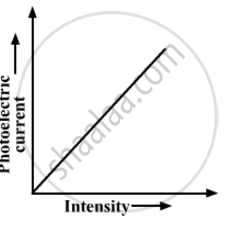Advertisements
Advertisements
प्रश्न
Draw a plot showing the variation of photoelectric current versus the intensity of incident radiation on a given photosensitive surface.
उत्तर

APPEARS IN
संबंधित प्रश्न
The photoelectric current in a photoelectric cell can be reduced to zero by a stopping potential of 1.8 volt. Monochromatic light of wavelength 2200Å is incident on the cathode. Find the maximum kinetic energy of the photoelectrons in joules. [Charge on electron = 1.6 x 10-19 C]
Draw a neat labelled circuit diagram of experimental arrangement for study of photoelectric effect.
Light of intensity ‘I’ and frequency ‘v’ is incident on a photosensitive surface and causes photoelectric emission. What will be the effect on anode current when the anode potential is increased? In each case, all other factors remain the same. Explain, giving justification in each case.
A photosensitive surface emits photoelectrons when red light falls on it. Will the surface emit photoelectrons when blue light is incident on it? Give reason.
Draw a plot showing the variation of photoelectric current with collector potential for different frequencies but same intensity of incident radiation ?
What change will you observe if intensity of incident radiation is changed but the frequency remains the same?
With reference to the photoelectric effect, what is meant by threshold wavelength?
Two metals A and B have work functions 4 eV and 6 eV respectively. Which metal has a lower threshold wavelength for photoelectric effect?
Plot a labelled graph of IVsl where Vs is stopping potential versus frequency f of the incident radiation.
Consider an electron in front of metallic surface at a distance d (treated as an infinite plane surface). Assume the force of attraction by the plate is given as `1/4 q^2/(4πε_0d^2)`. Calculate work in taking the charge to an infinite distance from the plate. Taking d = 0.1 nm, find the work done in electron volts. [Such a force law is not valid for d < 0.1nm].
